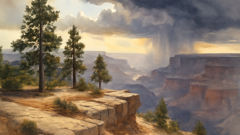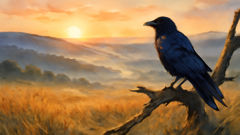Introduction
On the edge of a wind-carved plateau where the grass bends toward the horizon and clouds spill into the canyons, people tell of a bird that does more than fly. The Thunderbird is a living weather system, a spirit wearing feathers, a drumbeat in the air. When its wings slice the stillness, thunder rattles the pines; when its eyes flare, lightning etches shimmering sigils across the blue. This is not a relic tucked away in a cave nor a tale whispered by elders sitting by a fire; it is a current that runs through the nation, a thread that ties mountain tribes to prairie towns, deserts to river valleys. The myth invites every listener—child with a backpack, grandmother with a memory of winters, truck driver on a long road, scientist watching heatmaps—to pause and listen. For listening is the first act of respect, and respect is the first spark of wisdom. The Thunderbird does not merely threaten or awe; it invites, challenges, and forgives. Its weather is a language, and those who learn to read its cues discover a vocabulary of balance: water belongs to all who care for it; birds and salmon share the air and the streams; human hands are responsible not only for what they build but for what they allow to erode. Across the United States, the myth travels like a current—from cedar smoke to electric grids, from red rocks to chrome towns—carrying a message about courage that does not shout but trembles the horizon, about wisdom that does not boast but settles in the bones. The Thunderbird is a guardian of memory and a teacher of tomorrow. It does not demand allegiance, but asks for attention. If you listen long enough, the storm will teach you the oldest lessons: that power without care becomes danger, that strength without mercy harms more than it helps, that storms, like stories, pass—if we choose to learn from them and change our ways.
Section I — Calling the Sky
The morning air carried the scent of pine sap and rain before the first gray light touched the ridge. A young park ranger named Lena had come to the plateau with a notebook full of questions and a stubborn belief that storms were puzzles to be solved, not invitations to listen. The land had signs, she told herself, and if she learned to read them, she could save water, save people, and save the rivers she loved. On the first day, the wind spoke in a language that was almost a song. It whispered through the needles, it rasped in the dry grass, and then, with a suddenness that shook dust from the rocks, it rose into a chorus. A great wingbeat rose behind the shoulder of the mountain, a tremor that rolled through the valley like a drum. The Thunderbird appeared not as a single bird but as a presence—the air hummed with its mass, the horizon brightened with its edge, and every living thing paused to listen. Lena stood still, feeling the wind rearrange the shapes of her thoughts. She was not alone on the plateau; an elder from a nearby pueblo stood beside her, eyes calm, hands knotted with age and time. He spoke softly, not to rebuke but to guide. The Thunderbird, he explained, does not come to conquer the weather; it comes to remind the weather that it is watched. When the wings whip the air into noise, the land remembers its own heartbeat; when the eyes flash, the soil learns to hold water for the creatures who need it. The elder told a story of a drought that stretched across rivers and towns, of a people who learned to share rain and harvest. The Thunderbird had taught them to wait for the signs, to trade impatience for patience, to plant seeds in the soil that would sit through the long hot weeks and sprout when the season allowed. Lena listened even when the wind tried to carry her voice away, and in the listening there was a kind of healing. The myth began not with a conquest but with a vow to stay present, to watch the sky as if it were a neighbor and to treat every cloud as a memory the land might need later. A shadow moved behind the clouds, a silhouette of power that did not belong to any ordinary creature. It was the Thunderbird, larger than life and closer than dream, circling to remind the people that storms are shared, not owned, and that courage is not the absence of fear but the discipline to act anyway. The elder raised his hand toward a distant thunderhead and spoke a single word in the old tongue, a word that meant both return and responsibility. The ground responded with a subtle tremor; the trees rustled as if they remembered a rain they once had and promised to remember again.

Section II — The Eye of Lightning
The second day, Lena walked farther along a shale trail toward a river that vanished in the heat of summer, tracing the faint path where fish returned during the bright, short evenings. The elder walked beside her, ever patient, letting the pace slip into the rhythm of the land. Then the Thunderbird came again, not with a roar of wind but with something sharper, a spark of light that flickered between the clouds and the edge of the river. Its eyes flashed like twin suns, and for a heartbeat the world seemed to hold its breath. Then suddenly, a bolt of lightning split the sky in a jagged line, a line that did not end in destruction but in a new kind of clarity. The lightning cut through the smoke of a distant burn and landed in the river, not in violence but in a bright invitation: a path to follow, a signal of mercy, a warning against needless waste. The elder told Lena that lightning is not merely rain's tantrum; it is a reminder of the electricity that runs through every creature, a spark that can both start a fire and light a way out of darkness. The Thunderbird uses its eyes like an orchestra conductor uses a baton, guiding the elements to perform in balance: wind to clear the smoke, rain to fill the reservoirs, earth to keep the seeds from washing away. Yet there was a challenge in the light, too. A logging company had begun to carve a route along the river, threatening to sever the trees that held the soil together and the fish that fed the town. The Thunderbird did not back away from this reality. In that instant Lena understood a deeper part of the myth: power without accountability becomes erosion. She joined with others who petitioned and planned, learning to translate the language of the storm into the language of policy, science, and community care. The moment the bolt touched the river, the river did not boil or vanish; it glowed with new vitality, and the fish rose in a chorus of silver, as if thanking the sky for showing them a safer passage. The Thunderbird’s flash opened a space for humans to act with both awe and responsibility, a blend of courage and wisdom that keeps rivers strong and forests thriving.

Section III — A Covenant of Winds
On the third morning the air carried a scent of rain and resin, and the horizon wore a pale veil as if the world was considering a new coat. The Thunderbird descended not with a shout but with a hush, a hush that pressed the air toward stillness and invited a promise rather than a conquest. The elder spoke again, this time with a voice that seemed to come from the earth itself, a patient whisper through the bark of an old cedar. The Thunderbird was not a god to be placated but a partner who required partnership. Its wings beat a careful rhythm, bringing thunder that sounded like the pulse of a village at dusk and lightning that traced the stories of every river and ridge. The agreement it offered was simple and old as the first rain: care for the land, share its gifts, heal what has been harmed, and teach the next generation to do the same. Lena, who had come hoping to save water, found that the myth asked her to save stories as well, to transmit the memory of this moment to others who would build new skies for children who did not yet know the pain of drought. The people gathered, including farmers, students, elders, and a few travelers who had wandered into the valley and stayed to learn. They spoke of wells running dry, of a mountain spring that children used to drink from on hot days, of a forest that breathed with a steady, quiet life when the season and the skies allowed. The Thunderbird listened, and when it spoke, its voice was both gentle and loud, like rain against a cliff and a drumbeat that could travel across the plains. It reminded them that the storm is a shared instrument, that every saved drop of water, every tree spared from the chainsaw, every fish counted in a stream, is a note in a larger melody. The covenant did not end the storm; it guided it, tuning human hands to the music of the world so that future generations might hear the same thunder, see the same lightning, and know that courage and wisdom can be learned from a bird that never forgets the land that raised it. The myth closes with a quiet, almost shy, blessing: look up, listen, and act, for the Thunderbird is not merely a wind-borne omen but a teacher who asks that we become stewards, not conquerors, of this living country.

Conclusion
The storm passes, as storms always pass, but the lessons linger. The Thunderbird does not vanish when the clouds break; it becomes part of the memory that shapes decisions. The myth, shared around schoolyards and council meetings, in campfire shadows and kitchen tables, asks each person to translate awe into action: to protect water, to slow the machines that chew at the earth, to teach younger generations to see a storm as a message rather than a threat. In the end, the land and its people stand a little taller, listening a little more closely, grateful for a sky-spirit who teaches by example: power tempered with responsibility, courage followed by care, lightning guided by wisdom, and thunder turned into a vow to heal what has been harmed. If you are listening now, you are part of this ongoing story. The Thunderbird is not a tale from the distant past; it is a living invitation to help the world breathe easier, to hold fast to the sources of life, and to carry forward the thunder without breaking the land that gives it sound.


















